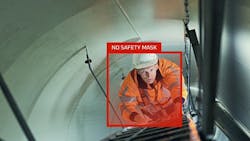AI device offers zero-blind-spot safety in offshore confined spaces
By Gary Ng, viAct
The offshore industry is no stranger to high-risk environments, but confined spaces within it present a unique challenge that has often been met with incomplete solutions.
When an offshore platform is alive with activity, workers in protective gear move in sync, but their voices are barely audible over the crashing waves and the hum of machinery.
Or, deep below deck, an inspection technician will descend into a crude oil storage tank, which is a confined space where danger lurks in unseen pockets of gas, fluctuating oxygen levels and the ever-present risk of human error. Despite following the traditional safety protocol—a checklist, a gas detector clipped to their suit and a radio link to their supervisor—manual checks leave room for blind spots.
Within minutes, that technician's breathing could become shallow due to a silent gas leak. But what if the technician's radio is out of reach and their team is unaware? This is the reality of confined space accidents.
Now imagine if AI had been watching. The challenge with confined spaces isn’t just the hazard itself—it’s the delay in response.
An AI-powered edge device serves as the crucial bridge between the unknown depths of confined spaces and the safety monitoring offices, ensuring no worker is left unprotected, no danger goes undetected and no industry operates with blind spots.
Case study: maintenance of crude oil storage tanks
In a recent case of an oil and gas giant from Saudi Arabia, viMOV, an edge AI device by viAct, was deployed for monitoring works at crude oil storage tanks.
The HSE team reported a drastic decline of 80% in unauthorized entry cases, which otherwise was a major antecedent of fatal accidents. viMOV’s edge AI alerts with 98.6% accuracy when an untrained worker unknowingly approaches a restricted maintenance area of these tanks. As the worker moved closer, the device detected the unauthorized access in real time and triggered an alert of flashing warning lights and emitting an audible signal. This immediate intervention stopped the unauthorized untrained workers 99.2% of the time before they could enter, ensuring that only certified personnel accessed the confined crude oil storage tanks, reducing accident risks by an estimated 87.4%.
During routine inspection, viMOV also played a key role in enforcing safety protocols by detecting non-compliance with PPE by any technician while working in the confined compartment. The local alarm installed with the viMOV system triggered an alarm for real-time monitoring, instantly alerting the control room. In more than 95.5% of recorded cases, such alerts resulted in immediate corrective action by supervisors. By improving compliance with PPE protocols by 10x, the device significantly reduced exposure to hazardous conditions in confined crude oil storage tanks.
On separate occasions, viMOV demonstrated its life-saving capabilities when it detected an unexpected oxygen level drop inside a confined chamber. With 99.1% precision, the system identified the anomaly and integrated it with the platform’s emergency response mechanisms. The automated ventilation protocols in such cases were triggered within 2.3 seconds, and nearby personnel were notified, which otherwise took the HSE team about 1 hour in most of the cases. This enabled a 92.7% successful evacuation rate before conditions deteriorated further.
In each scenario, viMOV proved its ability to not only detect hazards but to predict, alert and initiate real-time protective measures, transforming confined space monitoring into an intelligent, autonomous safety solution.
Integration and automation
viMOV effortlessly fits into existing safety infrastructures. Unlike traditional surveillance setups that require extensive reconfiguration, the device is designed for plug-and-play deployment with 50 hours of battery life.
Its edge AI capabilities mean it doesn’t rely on cloud-based processing, making it highly efficient even in remote offshore locations with limited electricity and internet availability.
For offshore industries navigating strict compliance regulations, from OSHA to IMO standards, viMOV automates compliance documentation, mitigates risks before they escalate and provides a level of surveillance that human supervisors cannot match.
AI and the future of offshore safety
The adoption of AI-driven edge devices is just the beginning of a larger transformation in offshore safety. As AI continues to evolve, the future of confined space monitoring will shift toward fully automated risk mitigation, where intelligent highly mobile AIoT devices can predict hazards before they happen and take corrective action without human intervention.
With real-time data analytics, offshore operators will have the ability to simulate and predict accident patterns, allowing safety teams to refine protocols based on AI-driven insights rather than historical incidents.
This shift will reduce workplace accidents and create an offshore environment where every confined space is under 24/7 intelligent supervision, without requiring excessive human oversight.
About the Author

Gary Ng
Gary Ng, CEO and co-founder of viAct, comes with a background of building engineering who turned into AIpreneur with the inception of viAct in 2016. He has 10+ years of experience in implementing technological innovations in the construction industry.
For offshore oil and gas operations, viAct's scenario-based AI uses video analytics to ensure accurate, real-time monitoring of safety conditions with immediate visibility to protect manpower, machine and material.
Before viAct, Ng was the managing director of 3D fashiontech EFI Optitex. He was also rewarded as the best regional senior executive in NASDAQ-listed technology enterprise Stratasys.
He believes in the concept of transferring knowledge from experienced industry experts to young professionals and is a renowned academic professional. Currently he is a visiting faculty professional at The Hong Kong Polytechnic University. He is also an active public speaker and preacher of AI-driven sustainability in workplaces.
